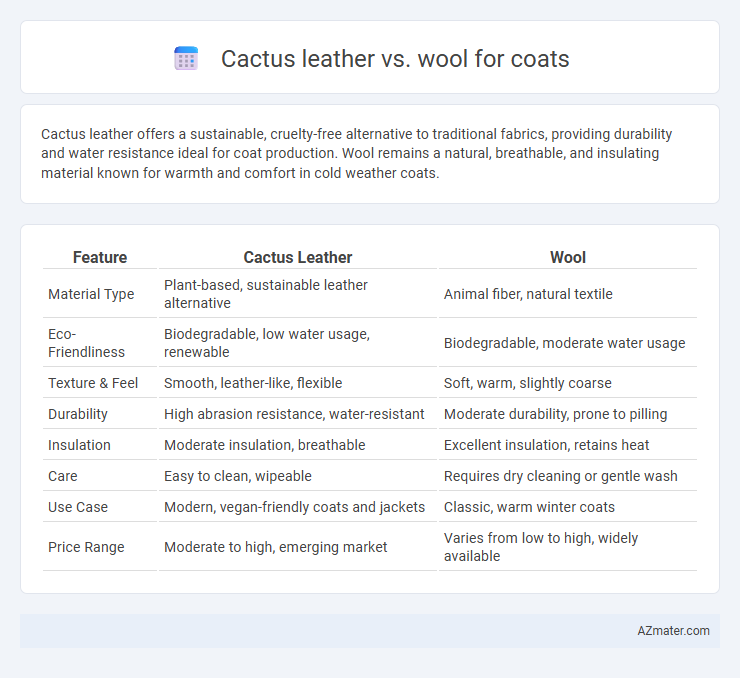Cactus leather offers a sustainable, cruelty-free alternative to traditional fabrics, providing durability and water resistance ideal for coat production. Wool remains a natural, breathable, and insulating material known for warmth and comfort in cold weather coats.
Table of Comparison
| Feature | Cactus Leather | Wool |
|---|---|---|
| Material Type | Plant-based, sustainable leather alternative | Animal fiber, natural textile |
| Eco-Friendliness | Biodegradable, low water usage, renewable | Biodegradable, moderate water usage |
| Texture & Feel | Smooth, leather-like, flexible | Soft, warm, slightly coarse |
| Durability | High abrasion resistance, water-resistant | Moderate durability, prone to pilling |
| Insulation | Moderate insulation, breathable | Excellent insulation, retains heat |
| Care | Easy to clean, wipeable | Requires dry cleaning or gentle wash |
| Use Case | Modern, vegan-friendly coats and jackets | Classic, warm winter coats |
| Price Range | Moderate to high, emerging market | Varies from low to high, widely available |
Introduction to Eco-Friendly Coat Materials
Cactus leather and wool stand out as sustainable materials for eco-friendly coats, each offering unique environmental benefits. Cactus leather is a plant-based alternative made from nopal cactus leaves, providing a biodegradable and cruelty-free option that reduces water usage compared to traditional leather. Wool, sourced from sheep, is a renewable and biodegradable fiber known for its natural insulation properties, making both materials excellent choices for environmentally conscious outerwear.
What Is Cactus Leather?
Cactus leather is an innovative, sustainable material derived from the mature leaves of the nopal cactus, processed into a durable, vegan alternative to traditional leather. Unlike wool, which is a natural fiber harvested from sheep, cactus leather offers water resistance, breathability, and a cruelty-free manufacturing process with a significantly lower environmental footprint. This plant-based leather provides a modern, eco-conscious option for coats, combining texture and strength while supporting sustainable fashion initiatives.
Understanding Wool: A Natural Fiber
Wool, a natural fiber derived from sheep fleece, offers excellent insulation, breathability, and moisture-wicking properties ideal for coat construction. Its fibers trap air effectively, providing warmth while remaining lightweight and durable under variable weather conditions. Unlike synthetic or plant-based alternatives like cactus leather, wool's renewable and biodegradable nature makes it a sustainable choice in high-performance outerwear.
Production Process: Cactus Leather vs Wool
Cactus leather is produced using sustainable methods where mature cactus leaves are harvested, cleaned, mashed, and then dried into flexible, durable sheets, minimizing water usage and chemical treatments compared to traditional leather. Wool production involves shearing sheep, cleaning the raw wool to remove impurities, carding to align fibers, and spinning into yarn, a process that requires water, energy, and careful animal husbandry. While cactus leather's production emphasizes environmental conservation and plant-based resources, wool production depends on animal welfare and has a higher ecological footprint due to resource-intensive farming practices.
Environmental Impact Comparison
Cactus leather production uses significantly less water and generates fewer greenhouse gas emissions compared to wool, which involves extensive water usage and methane release from sheep. Unlike wool, cactus leather avoids issues of soil degradation and overgrazing, promoting more sustainable land use. The biodegradable nature of both materials supports eco-friendly disposal, but cactus leather's plant-based origin results in a lower overall environmental footprint.
Durability and Longevity
Cactus leather offers notable durability with its resistance to cracking and fading, making it an eco-friendly alternative that maintains its appearance over time. Wool is renowned for its natural elasticity and resilience, providing long-lasting warmth and resistance to wear from regular use. Both materials deliver excellent longevity, but cactus leather excels in moisture and stain resistance, while wool excels in insulation and breathability.
Comfort and Breathability
Cactus leather offers a smooth, lightweight texture with moderate breathability, making it comfortable for coats in milder climates. Wool provides superior insulation and natural moisture-wicking properties, enhancing comfort and breathability in colder weather conditions. The choice depends on the desired warmth and ventilation levels, with wool excelling in breathability and temperature regulation.
Style and Fashion Versatility
Cactus leather offers a sleek, modern aesthetic with a vegan-friendly appeal, making it ideal for edgy, sustainable fashion statements in coats. Wool provides classic elegance, superior warmth, and a timeless look that adapts effortlessly to both casual and formal styles. Combining durability with trend versatility, wool remains a staple for versatile coat designs, while cactus leather pushes boundaries in innovative, eco-conscious fashion.
Pricing and Market Availability
Cactus leather is a vegan alternative with prices typically higher than traditional wool due to its sustainable production process and emerging market presence. Wool remains widely available and cost-effective, benefiting from an established supply chain and mass production. Market availability for cactus leather coats is limited, predominantly found in niche boutiques and premium eco-conscious brands.
Which Is Better for Sustainable Coats?
Cactus leather offers a highly sustainable alternative to traditional materials due to its plant-based origin, low water usage, and biodegradable properties, making it an eco-friendly choice for coats. Wool, while renewable and biodegradable, often involves resource-intensive animal farming and methane emissions, which impact sustainability. For sustainable coats, cactus leather generally outperforms wool by minimizing environmental footprints through its innovative production methods and cruelty-free nature.

Infographic: Cactus leather vs Wool for Coat
 azmater.com
azmater.com